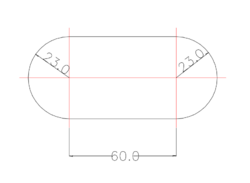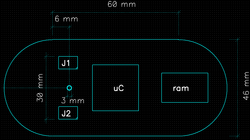Projects/Envirobot
(→Sensor Interface) |
(→Sensor Interface) |
||
| Line 38: | Line 38: | ||
[[File:Envirobot_SensorSystem_MezzConnectors.PNG|thumb|250px|Placement of Sensor Connectors]] | [[File:Envirobot_SensorSystem_MezzConnectors.PNG|thumb|250px|Placement of Sensor Connectors]] | ||
| − | The SensorCtrl board provides power | + | The SensorCtrl board provides power, a serial bus, an I2C bus as well as an SPI bus, a Digital Camera Interface, 3 ADC inputs and 3 timer outputs. |
| + | Altough an additional 5V power supply is provided to the sensors, the GPIOs of the processor only supports 3.3V. If a sensors works with other levels, a level translation circuit has to be implemented on the mezzanine board. | ||
The pinning of the two [http://www.digikey.ch/product-detail/de/DF12(3.0)-20DS-0.5V(86)/H11748CT-ND/2172540 Hirose DF12(3.0)-20DS-0.5V(86)] connectors is given in the table below. | The pinning of the two [http://www.digikey.ch/product-detail/de/DF12(3.0)-20DS-0.5V(86)/H11748CT-ND/2172540 Hirose DF12(3.0)-20DS-0.5V(86)] connectors is given in the table below. | ||
Of course all pins can also be configured to work as simple GPIOs. | Of course all pins can also be configured to work as simple GPIOs. | ||
Revision as of 12:02, 15 October 2015
|
The aim of the Nano-Tera Envirobot project is to build an aquatic robot to measure the water quality at different locations in waters. It's our mission to integrate the many different sensors into the robot.
Sensor System
Integrating chemical and biological sensor into the Envirobot we had to face several challenges. First of all, as most sensors are still under heavy development, their interfaces towards the robot are not yet completely defined. Therefore the system has to be as flexible as possible. Opposing to this, the system has to be small enough to fit into the swimming robot, which consists of about seven more or less independent segments. To fulfill these requirements, a modular approach has been chosen.
A sensor systems is based on a generic SensorCtrl board, which links to the main system of the Envirobot and provides a generic interface for sensors. This board carries SensorCtrl_Mezz boards, which are specific for each sensor.
The whole sensor system is packed in a special compartment below a locomotion segment of the Envirobot. Here the part containing the electronic boards is meant to be generic, whereas the cover can be modified for each sensor.
With this setup a maximal flexibility is achieved, as only the SensorCtrl_Mezz board and the segment's cover have to be modified when a new sensor is included in the Envirobot.
Mechanics
We decided to differentiate between larger and smaller sensors. Small sensors can be stacked below an existing locomotion segment whereas large sensors need to be packed into a dedicated sensor segment of the Envirobot. To be as less intrusive as possible, we decided to implement the second version in a first approach. The version with the dedicated segment will be kept back until there is an especially large sensor.
The whole sensor system is packed in a special compartment below a locomotion segment of the Envirobot. The compartment is directly integrated into the lower cover of the locomotion segment and has itself a detachable cover. Like this, there is no need to waterproof any connector between the sensor system and the locomotion segment. This part of the compartment is meant to be the same for all sensors. To have a truly modular system, the sensor compartment’s cover can be adapted for each sensor.
The sensor compartment attached to the bottom of a locomotion segment has an oval space of 10 cm x 4 cm. In height, there are about 2 cm of free vertical space for sensor placement. If the sensor needs more vertical space, the cover’s border can be heightened. Two screws are integrated into the compartment, which can be used to hold the sensors in place.
In the current setup there are about 2 cm between the mezzanine and the cover. If the sensor needs more vertical space, the cover can be adapted.
The SensorCtrl_Mezz board can be fixed to the SensorCtrl board with a 2mm screw placed between the connectors.
SensorCtrl
This generic platform contains a STM32F429ZIT6 microcontroller. It serves as interface between the various sensors and the robots' head. The connection to the robot is realized over a CAN bus.
To test the platform in a real environment, i.e. on a lake, a test system using a serial interface over bluetooth has been developed.
Sensor Interface
The SensorCtrl board provides power, a serial bus, an I2C bus as well as an SPI bus, a Digital Camera Interface, 3 ADC inputs and 3 timer outputs. Altough an additional 5V power supply is provided to the sensors, the GPIOs of the processor only supports 3.3V. If a sensors works with other levels, a level translation circuit has to be implemented on the mezzanine board. The pinning of the two Hirose DF12(3.0)-20DS-0.5V(86) connectors is given in the table below. Of course all pins can also be configured to work as simple GPIOs.
| Pin | J1 | J2 |
|---|---|---|
| 1 | 3.3V (0.5A) | 5V (1A) |
| 2 | USART2_RX | DCMI_D6 |
| 3 | USART2_TX | DCMI_D10 |
| 4 | USART2_CX | DCMI_D4 |
| 5 | GND | DCMI_D11 |
| 6 | DCMI_HSYNC | DCMI_D7 |
| 7 | DCMI_PIXCK | DCMI_D12 |
| 8 | DCMI_D1 | DCMI_D2 |
| 9 | DCMI_D0 | DCMI_D13 |
| 10 | DCMI_D3 | GND |
| 11 | DCMI_D8 | DCMI_VSYNC |
| 12 | DCMI_D9 | TIM10_CH1 |
| 13 | DCMI_D5 | I2C2_SCL |
| 14 | GND | TIM11_CH1 |
| 15 | ADC1_IN0 | I2C2_SDA |
| 16 | GND | TIM13_CH1 |
| 17 | ADC1_IN1 | SPI6_MISO |
| 18 | GND | SPI_SCK |
| 19 | ADC1_IN2 | SPI6_MOSI |
| 20 | GND | GND |
Mezzanines
Conductivity
The conductivity of the water is measured with the EZO EC circuit from Atlas Scientific. We use the I2C protocol to calibrate it with the water temperature and get its readings back. This circuit connects to probes immersed in the water outside the Envirobot.
The temperature of the water is measured with the TSYS01 temperature sensor. It has an accuracy of 0.1°C and a digital resolution of 24 bit. accessed by I2C on the address 1110110x. The sensor is fixed onto a metal disc, which is in direct contact with the water outside the Envirobot.
Navigation
![]() USLO
USLO
![]() Projects
CubeCluster
Projects
CubeCluster ![]()




